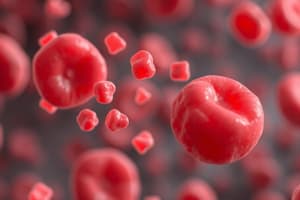Podcast
Questions and Answers
Where does the process of haemopoiesis start in human development?
Where does the process of haemopoiesis start in human development?
- Liver
- Bone marrow
- Yolk sac (correct)
- Spleen
Which cell type is responsible for transporting oxygen, nutrients, carbon dioxide, and waste products in the blood?
Which cell type is responsible for transporting oxygen, nutrients, carbon dioxide, and waste products in the blood?
- Platelets (thrombocytes)
- Stem cells
- White cells (leucocytes)
- Red cells (erythrocytes, RBC) (correct)
What is the main function of plasma in blood composition?
What is the main function of plasma in blood composition?
- Transporting oxygen
- Producing red blood cells
- Initiating immune response
- Carrying nutrients (correct)
At what stage does bone marrow take over the responsibility of haemopoiesis in a developing human embryo?
At what stage does bone marrow take over the responsibility of haemopoiesis in a developing human embryo?
What are the average size dimensions of a normal red blood cell (RBC)?
What are the average size dimensions of a normal red blood cell (RBC)?
What is the primary function of reticulocytes in blood?
What is the primary function of reticulocytes in blood?
What is the average hemoglobin concentration in a red blood cell?
What is the average hemoglobin concentration in a red blood cell?
Which stage of erythropoiesis comes after the proerythroblast?
Which stage of erythropoiesis comes after the proerythroblast?
What are the three essential dietary constituents for erythropoiesis?
What are the three essential dietary constituents for erythropoiesis?
In terms of red cell indices, how is anemia classified?
In terms of red cell indices, how is anemia classified?
What are the pathological consequences of anemia?
What are the pathological consequences of anemia?
Which laboratory finding indicates anisocytosis in a blood film?
Which laboratory finding indicates anisocytosis in a blood film?
What is the commonest cause of anaemia due to haematinic deficiency?
What is the commonest cause of anaemia due to haematinic deficiency?
Which of the following is NOT a mechanism of iron deficiency leading to anaemia?
Which of the following is NOT a mechanism of iron deficiency leading to anaemia?
In iron metabolism, iron is stored as:
In iron metabolism, iron is stored as:
Which of the following is a reason for failure to respond to iron therapy in cases of iron deficiency anaemia?
Which of the following is a reason for failure to respond to iron therapy in cases of iron deficiency anaemia?
What type of anaemia is characterized by microcytic and hypochromic red blood cells?
What type of anaemia is characterized by microcytic and hypochromic red blood cells?
What characterizes megaloblastic anaemia in the bone marrow?
What characterizes megaloblastic anaemia in the bone marrow?
Which factor is essential for DNA synthesis in the biochemical basis of megaloblastic anaemia?
Which factor is essential for DNA synthesis in the biochemical basis of megaloblastic anaemia?
What is the primary source of Vitamin B12?
What is the primary source of Vitamin B12?
What condition can lead to Vitamin B12 deficiency?
What condition can lead to Vitamin B12 deficiency?
Which of the following is a common cause of folate deficiency?
Which of the following is a common cause of folate deficiency?
What is the function of Intrinsic Factor (IF) in Vitamin B12 absorption?
What is the function of Intrinsic Factor (IF) in Vitamin B12 absorption?
Fe+++ is absorbed as Fe++ with the help of gastric HCl.
Fe+++ is absorbed as Fe++ with the help of gastric HCl.
Iron is stored in the body as ferrous sulfate and hemosiderin.
Iron is stored in the body as ferrous sulfate and hemosiderin.
Fe deficiency anaemia can be caused by increased iron demands.
Fe deficiency anaemia can be caused by increased iron demands.
Oral iron therapy is usually ineffective in treating iron deficiency anemia.
Oral iron therapy is usually ineffective in treating iron deficiency anemia.
Chronic inflammation, including infectious diseases like TB and malaria, can lead to iron deficiency anemia.
Chronic inflammation, including infectious diseases like TB and malaria, can lead to iron deficiency anemia.
In adult life, extramedullary haemopoiesis is the main site of blood cell production.
In adult life, extramedullary haemopoiesis is the main site of blood cell production.
Myeloid stem cells differentiate into red cells, white cells, and platelets.
Myeloid stem cells differentiate into red cells, white cells, and platelets.
The normal range for red blood cell count in adult females is 4.5 - 6.5 x10^12/l.
The normal range for red blood cell count in adult females is 4.5 - 6.5 x10^12/l.
The average size of a red blood cell is 17.5 µm.
The average size of a red blood cell is 17.5 µm.
Mature cells are the earliest recognisable precursors in blood cell differentiation.
Mature cells are the earliest recognisable precursors in blood cell differentiation.
Reticulocytes account for 1% of total white blood cell count.
Reticulocytes account for 1% of total white blood cell count.
The average hemoglobin concentration in a red blood cell is 80-95 g/dl.
The average hemoglobin concentration in a red blood cell is 80-95 g/dl.
Reticulocytes are the final stage of maturation in the process of erythropoiesis.
Reticulocytes are the final stage of maturation in the process of erythropoiesis.
Erythropoietin is not required for the process of erythropoiesis.
Erythropoietin is not required for the process of erythropoiesis.
Anisocytosis refers to a variation in shape of red blood cells seen in a blood film.
Anisocytosis refers to a variation in shape of red blood cells seen in a blood film.
Poikilocytosis is a characteristic feature of megaloblastic anemia.
Poikilocytosis is a characteristic feature of megaloblastic anemia.
Iron deficiency is classified as a normochromic normocytic type of anemia based on red cell indices.
Iron deficiency is classified as a normochromic normocytic type of anemia based on red cell indices.
Megaloblastic anemia can be characterized by the presence of megaloblasts in the bone marrow.
Megaloblastic anemia can be characterized by the presence of megaloblasts in the bone marrow.
Folate deficiency can lead to hypersegmented neutrophils in peripheral blood.
Folate deficiency can lead to hypersegmented neutrophils in peripheral blood.
Abnormal metabolism of B12 and folate is not a cause of megaloblastic anemia.
Abnormal metabolism of B12 and folate is not a cause of megaloblastic anemia.
Folate is primarily sourced from dairy produce.
Folate is primarily sourced from dairy produce.
B12 deficiency can be caused by a congenital lack of Intrinsic Factor (IF).
B12 deficiency can be caused by a congenital lack of Intrinsic Factor (IF).
Crohn's disease can lead to folate deficiency due to malabsorption.
Crohn's disease can lead to folate deficiency due to malabsorption.
Study Notes
- Blood is composed of plasma (55%) and cells (40-45%), including red cells (erythrocytes), white cells (leucocytes), and platelets (thrombocytes).
- Haemopoiesis, the process of blood cell production, starts in the yolk sac during gestation, then moves to the liver and spleen (extramedullary) before settling in the bone marrow.
- Blood cell differentiation involves pluripotential stem cells, myeloid or lymphoid stem cells, committed stem cells, and mature cells.
- Erythropoiesis is the process of red blood cell production and involves stages like proerythroblast, erythroblast, reticulocyte, and finally erythrocyte.
- Anemia is characterized by low hemoglobin levels, reduced red cell mass, and can be classified based on red cell indices like MCV.
- Causes of anemia include decreased production (e.g., aplastic bone marrow) and increased destruction/loss (e.g., hemorrhage).
- Iron deficiency is a common cause of microcytic, hypochromic anemia and can result from factors like increased demands, chronic blood loss, poor diet, or malabsorption.
- Megaloblastic anemia is characterized by megaloblasts in the bone marrow, large oval RBCs in the blood, and can be caused by vitamin B12 or folate deficiency, leading to defective DNA synthesis.
Studying That Suits You
Use AI to generate personalized quizzes and flashcards to suit your learning preferences.
Related Documents
Description
Learn about the overview of iron deficiency anaemia including causes, symptoms, and mechanisms. Explore the relationship between iron metabolism, blood picture, and common causes of anaemia.



